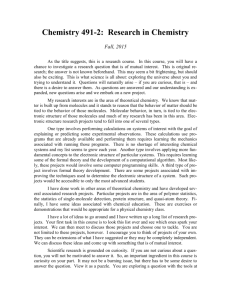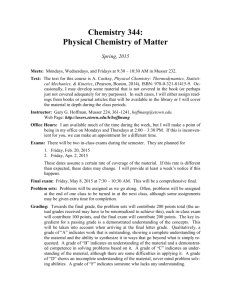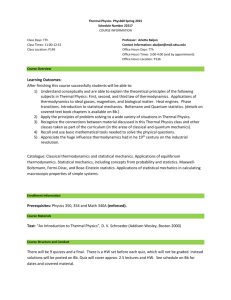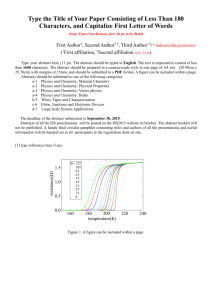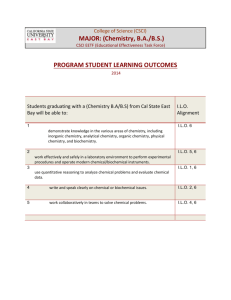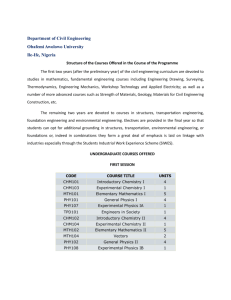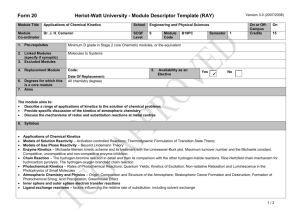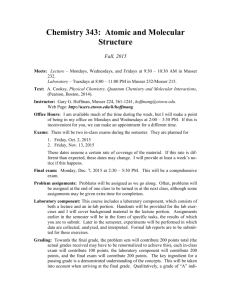Chemistry 343: Atomic Structure - My E-town -
advertisement
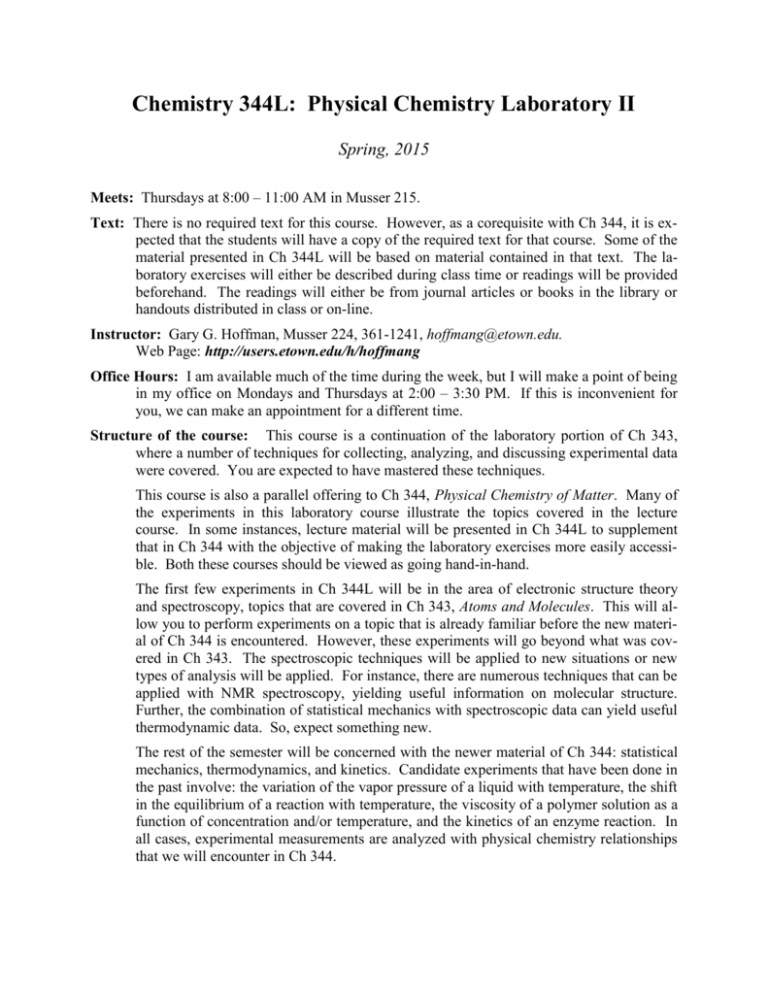
Chemistry 344L: Physical Chemistry Laboratory II Spring, 2015 Meets: Thursdays at 8:00 – 11:00 AM in Musser 215. Text: There is no required text for this course. However, as a corequisite with Ch 344, it is expected that the students will have a copy of the required text for that course. Some of the material presented in Ch 344L will be based on material contained in that text. The laboratory exercises will either be described during class time or readings will be provided beforehand. The readings will either be from journal articles or books in the library or handouts distributed in class or on-line. Instructor: Gary G. Hoffman, Musser 224, 361-1241, hoffmang@etown.edu. Web Page: http://users.etown.edu/h/hoffmang Office Hours: I am available much of the time during the week, but I will make a point of being in my office on Mondays and Thursdays at 2:00 – 3:30 PM. If this is inconvenient for you, we can make an appointment for a different time. Structure of the course: This course is a continuation of the laboratory portion of Ch 343, where a number of techniques for collecting, analyzing, and discussing experimental data were covered. You are expected to have mastered these techniques. This course is also a parallel offering to Ch 344, Physical Chemistry of Matter. Many of the experiments in this laboratory course illustrate the topics covered in the lecture course. In some instances, lecture material will be presented in Ch 344L to supplement that in Ch 344 with the objective of making the laboratory exercises more easily accessible. Both these courses should be viewed as going hand-in-hand. The first few experiments in Ch 344L will be in the area of electronic structure theory and spectroscopy, topics that are covered in Ch 343, Atoms and Molecules. This will allow you to perform experiments on a topic that is already familiar before the new material of Ch 344 is encountered. However, these experiments will go beyond what was covered in Ch 343. The spectroscopic techniques will be applied to new situations or new types of analysis will be applied. For instance, there are numerous techniques that can be applied with NMR spectroscopy, yielding useful information on molecular structure. Further, the combination of statistical mechanics with spectroscopic data can yield useful thermodynamic data. So, expect something new. The rest of the semester will be concerned with the newer material of Ch 344: statistical mechanics, thermodynamics, and kinetics. Candidate experiments that have been done in the past involve: the variation of the vapor pressure of a liquid with temperature, the shift in the equilibrium of a reaction with temperature, the viscosity of a polymer solution as a function of concentration and/or temperature, and the kinetics of an enzyme reaction. In all cases, experimental measurements are analyzed with physical chemistry relationships that we will encounter in Ch 344. I will take the attitude that the laboratory exercises are in the form of academic research projects. As a result, they will be chosen and developed mainly out of curiosity. I have enough curiosity to go around, but I would welcome any input from the class and we can develop experiments based on mutual interest. Handouts or reading assignments will be provided before each experiment is performed. With a few exceptions, you will perform an experiment each week and prepare a formal report for each one. Reports are due two weeks from the date the experiment is performed. That should give you sufficient time to perform an analysis of the data, repeat any questionable measurements, if necessary, and think about what conclusions can be drawn. Experiments will be performed in groups of two or three students. Because of equipment limitations, many of the experiments cannot be performed by everyone at the same time. Experiments will therefore be performed in rotation. You will be expected to keep a proper laboratory notebook at all times. You have learned how to do this in the other chemistry courses you have taken. I may ask you to turn in your notebooks occasionally. These occasions will not necessarily be announced beforehand. They will contribute to a portion of your grade. Let me finish with a comment on data collection. It is critical that you examine your data as you collect it and assess its quality before leaving the lab. You should have some idea of what the data should look like; generally, the reading assignment for the experiment will suggest what to expect. Take a careful look at your results and see if they are consistent with those expectations. If not, this is a sign that something may be wrong. Perhaps a solution was incorrectly prepared, or perhaps a valve was not closed as it should have been, or perhaps the spectrometer lamp was burned out. If you go home from lab assuming everything is fine, you may be in for a rude surprise when it comes to analyzing the data for your report. I feel that assessing your data is part of the experimental procedure. Failure to do so amounts to failing to complete the experiment. You will be graded accordingly. On the other hand, if you catch a flaw in your data at a later stage and would like to come in to lab to repeat the measurements, I would be happy to arrange a time with you. Student Learning Outcomes: After taking this course, the student is expected to be able to: Investigate chemical phenomena in the laboratory and analyze the data on the basis of statistical mechanics and/or thermodynamics. (Design, execute, and interpret experiments to solve chemical problems.) Analyze the behavior of a chemical system based on thermodynamic principles. Analyze the kinetics of a reaction and propose a reasonable reaction mechanism based on that analysis. These expectations are associated with the third and fourth SLO’s listed in the College Catalog: “Research a chemical problem or concept. Design, execute, and interpret experiments to solve chemical problems.” Grading: The grading will be based primarily on the reports that are turned in. Each report contributes equally to your overall grade. A smaller component will be based on your lab notebooks. Each time that you turn in your notebook will contribute a grade equal to half of a lab report. A principal factor in your grade is your ability to analyze the data properly and draw reasonable conclusions based on them. Qualitatively, a grade of “A” indicates a thorough understanding of what was done, fully correct analysis, and the ability to draw thoughtful conclusions. A grade of “B” indicates an understanding of the experiment, competent analysis (some minor errors perhaps), and reasonable conclusions. A grade of “C” indicates an understanding of the material but some flaws in the area of analysis or conclusions. A grade of “D” shows an incomplete understanding of the experiment and an “F” shows none. At the same time, it is important to obtain good data and the quality of your data will make a contribution to your grade. If your data are flawed, no amount of analysis will overcome this. Flawed data will lower the grade on your report by at least one letter grade. How much the grade is reduced depends on how well you can discuss it. You will be expected to explain the reason for the flaw, how it affected your results, how you could have prevented it, what you should have observed, and you should extract as much information from your data as you can. Corequisite: Chemistry 344, Molecular Structure and Mechanics. COURSE SYLLABUS STATEMENT ON DISABILITY Elizabethtown College welcomes otherwise qualified students with disabilities to participate in all of its courses, programs, services, and activities. If you have a documented disability and would like to request accommodations in order to access course material, activities, or requirements, please contact the Director of Disability Services, Lynne Davies, by phone (361-1227) or e-mail daviesl@etown.edu. If your documentation meets the college’s documentation guidelines, you will be given a letter from Disability Services for each of your professors. Students experiencing certain documented temporary conditions, such as post-concussive symptoms, may also qualify for temporary academic accommodations and adjustments. As early as possible in the semester, set up an appointment to meet with me, the instructor, to discuss the academic adjustments specified in your accommodations letter as they pertain to my class.
